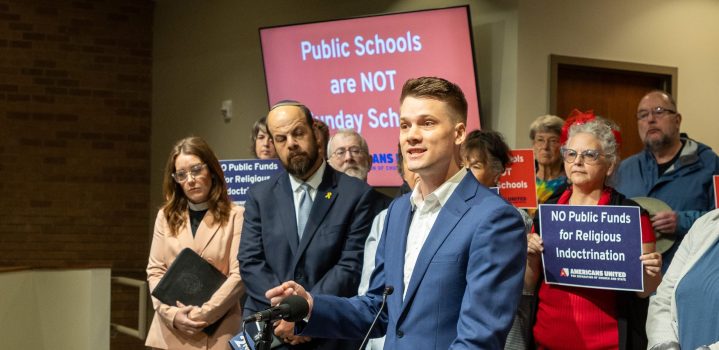
I spent the week in Oklahoma, where the mood was apprehensive. I met with faith and community leaders, each of whom expressed grave concerns about the erosion of church-state separation. We discussed several assaults on Oklahomans’ religious freedoms: a public-school Bible-education mandate; a disastrous new set of Christian Nationalist social-studies standards; and of course, a case that was argued before the U.S. Supreme Court yesterday involving an attempt to establish the nation’s first religious public school, St. Isidore of Seville Catholic Virtual School. The case, Oklahoma Statewide Charter School Board v. Drummond, could fundamentally alter our nation’s longstanding system of secular public education.
In the hours before yesterday’s Supreme Court oral arguments, I gathered in a Tulsa church with a group of clergy, public-school parents and educators to advocate for secular public schools that are open to all Oklahoma children. Then, I joined some local partners to listen to the arguments. The arguments were, at times, difficult to listen to. It was painful to hear advocates for St. Isidore brush aside the Constitution’s guarantee of church-state separation while ignoring the very real harms to Oklahomans that would result from a government-established religious school.
Community kept me going yesterday. I was reminded that while the future may be uncertain, we are never alone. In Oklahoma and across the nation, there will always be those who insist on togetherness despite our differences.
In yesterday’s case, St. Isidore and the Oklahoma Statewide Charter School Board (along with the Trump-appointed solicitor general) presented the court with a startling demand. Their argument goes something like this: By requiring that charter schools be secular, Oklahoma discriminates against religion. Therefore, they argue, Oklahoma must establish St. Isidore as a religious charter school that indoctrinates students, or else it violates St. Isidore’s religious freedom.
But as we pointed out in an amicus brief filed on behalf of Oklahomans, there’s a glaring problem with this argument. Oklahoma charter schools are public schools. They are governmental entities and state actors, meaning that they are constrained by the Constitution. The Constitution generally protects people’s rights from being violated by the government. It does not provide the government with a license to indoctrinate in the name of religious freedom.
During oral arguments, the lawyers for St. Isidore and company argued that, despite being defined and treated as public schools and governmental entities under state law, Oklahoma charter schools are actually private entities. And the justices’ questions focused primarily on the distinction between private and public entities.
Some of the justices seemed skeptical of the attempt to define charter schools as private. Justice Elena Kagan pointed out that, with the exception of St. Isidore, Oklahoma charter schools “look like regular public schools.” St. Isidore, Kagan pressed, is asking for special treatment by seeking a non-standard charter that allows for, among other things, religious indoctrination.
Justice Sonia Sotomayor posed an illuminating hypothetical to the charter board’s lawyer, which Justice Ketanji Brown Jackson returned to later in the argument. The justices asked the board’s lawyer to consider a hypothetical state government that wanted to have murals of landscapes painted on its buildings. If the state contracted with muralists to paint these landscapes, could it require the contractors to refrain from including religious symbols in the murals?
The board’s lawyer seemed to concede that, yes, the hypothetical state could impose such a requirement, because it would be “hiring someone to paint the government’s own message.” But charter schools, too, convey “the government’s own message.” For instance, their academic programs must align with state standards. More fundamentally, charter schools are the government under state law, so all official charter-school messages are “the government’s own message.”
This case is not particularly difficult. Just three years ago, the Supreme Court assured us that nothing prevents a state from “provid[ing] a strictly secular education in its public schools.” Now, the court is considering whether to strike down our system of strictly secular education in public schools. Hopefully, the court holds true to its assurances.
Photo: Author Luke Anderson, a constitutional litigation fellow at Americans United, discusses the Supreme Court case involving the nation’s first religious public school during an April 30, 2025, rally in Tulsa. Photo credit: Americans United/Tom Gilbert Photography